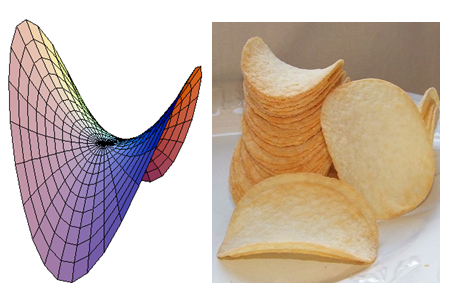Origami and GeoGebra – a slightly different version
For GeoGebra enthusiasts who are attending GeoGebra conferences, don’t throw your GeoGebra flyers. Watch the video and see how useful it is. 🙂
School math, multimedia, and technology tutorials.
For GeoGebra enthusiasts who are attending GeoGebra conferences, don’t throw your GeoGebra flyers. Watch the video and see how useful it is. 🙂
If your math teacher told you that mathematics is everywhere, believe him. Almost all the things that we see around (even things that we do not see) are related to mathematics — even potato chips. Yes, even potato chips.
Some potato chips, particularly Pringles (I hope they give me 500 bucks for this), are in a shape of a saddle. In mathematics a saddle-shaped graph is called a hyperbolic paraboloid (see left figure).

A hyperbolic paraboloid quadratic and doubly ruled surface given by the Cartesian equation . Now, whatever that means will be discussed when you take your analytic geometry course.
For now, let’s be happy that we know that even potato chips can be modeled by graphs. 🙂
***
Sources: Omg Facts, Pringle’s Site, Wolfram Math World
Photo Credit: Hyperbolic Paraboloid (Wikimedia), Pringles chips (Wikimedia)
This is a captivating video ‘inspired by numbers, geometry and nature’ and was created by Cristóbal Vila. The video explains the connections between the Fibonacci sequence 1,1,2,3,5,8,13, … (can you see the pattern?), and nature (the golden rectangle, the nautilus, the sunflower, etc.).
For non-math people, you will appreciate this video if you know the concepts behind it.
I came across with this video about two weeks ago, but I had no chance to post it until I was reminded by a post about it at the MathFuture wiki. On the funny side, there were more than 10 thousand who liked the video in Youtube, but 122 disliked it (plus a few more recently). One user (GatorTomKK) had the following comment for those 122 (and possibly for future ‘dislikers‘) :
122 people don’t understand math in general.
I can’t help but grin after reading the comment, and I’m sure your doing the same.